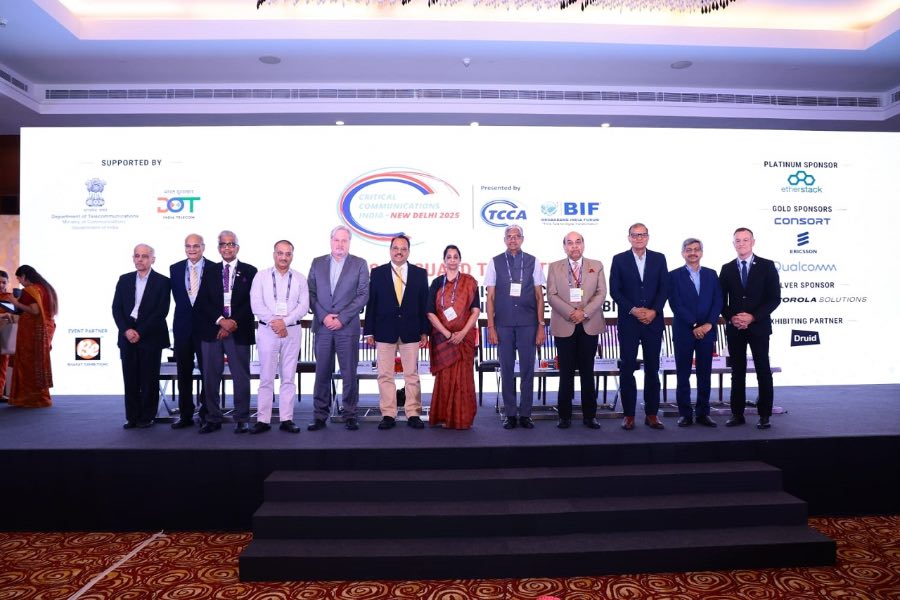
India’s First-Ever Mission-Critical Communications Conference, “Safeguard The Future”, concluded in New Delhi, setting a powerful stage for collaboration, knowledge sharing, and action toward strengthening the nation’s public safety and emergency preparedness infrastructure. Organized by the Broadband India Forum (BIF) in collaboration with TCCA, this landmark event laid the foundation for India to position itself as a global benchmark in mission-critical communications.
Shri Anil Kumar Lahoti, Chairman, TRAI graced the event as Chief Guest. Other esteemed dignitaries at the Inaugural included Lt. Gen. Syed Ata Hasnain (Retd), PVSM, UYSM, AVSM, SM, VSM, Member NDMA Board; Shri Manish Aggarwal, Spl. Commissioner, Delhi Police; Shri Sanjai Kumar, CMD, Railtel, and Dr. R.K. Upadhyay, CEO, C-DoT, the conference underscored the critical importance of mission-critical communications in ensuring national security, public safety, and effective disaster response.
In his address, the Chief Guest, Shri Lahoti said, “This subject carries immense strategic importance for both India and the global community as we navigate an era of rising climate vulnerabilities leading to natural disasters, challenges related to communications in managing urban environments and the increasingly complex security situations. Infrastructure, policies, spectrum, and standards are being rapidly developed to build integrated, secure national mission-critical communication systems for India. I congratulate BIF for organizing this pioneering conference.”
Special Guest of Honour, Lt Gen Syed Ata Hasnain (Retd), PVSM, UYSM, AVSM, SM, VSM, Member NDMA Board, remarked: “Disaster resilience is not a war against an enemy, but against the unknown. In preparing for uncertainty, communication becomes our strongest weapon—linking agencies, communities, and responders in real time, hence investing in interoperable, mission-critical networks is important for us to safeguard lives with speed, clarity, and confidence.”
The event fostered a spirit of global collaboration, with participation from leading international organizations and speakers, including Kevin Graham, CEO, TCCA, who highlighted the profound global lessons that countries like India can incorporate to enhance their emergency preparedness. He remarked, “Mission-critical communication users demand trusted, secure and reliable connectivity when and wherever required. By adopting international open standards and best practices in design, deployment and operation, end to end ecosystems, can ensure intra & interagency, national & cross border interoperability and resilience in the face of modern crises.”
Comprehensive discussions during the event explored the potential of mission-critical communications to revolutionize India’s disaster management framework. Sessions covered themes ranging from global case studies and the role of partnerships in securing private networks to the deployment of cutting-edge technologies like MCX solutions, certification processes, and real-time communication applications. Key contributors to these discussions included representatives from global technology leaders such as Motorola, Ericsson, Qualcomm, and Consort Digital offering perspectives on innovative solutions that can future-proof India’s communication infrastructure.
Reflecting on the need for strong collaboration between public and private stakeholders, Aruna Sundararajan, IAS (Retd), Chairperson, BIF, emphasized the power of partnerships in driving progress. She noted, “The discussions we have had today underline one critical point: safeguarding lives during emergencies is a shared responsibility. We must create a synergy between policymakers, regulators and industry leaders to build technologies and policies that can deliver real impact. This conference is not just a dialogue but the beginning of collective action toward a safer India.”
A highlight of the event was the session on disaster management, where experts from DoT, C-DoT, BSNL, and Railtel stressed the integration of mission-critical systems into India’s response strategies. The conference stood out for uniting diverse stakeholders, driving actionable takeaways on preparedness, resilience, and global alignment, and concluded with Smt. Sundararajan urging participants to turn this momentum into tangible outcomes to strengthen India’s emergency communication framework.
When the ground shakes—literally or metaphorically—it is communication that holds the chain of response together. In building resilient, mission-critical networks, our goal must be to ensure that lifesaving coordination flows uninterrupted, that every agency connects at every moment. Ultimately, in the struggle against the unknown, our greatest arsenal is not force.